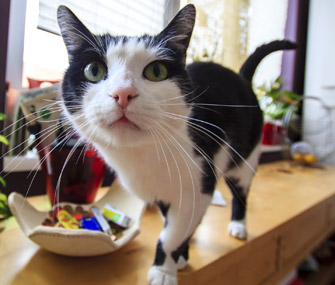Tips for Keeping Your Cat From Jumping On Counters and Tables
Published on March 31, 2015
Skip To

Preventing the Behavior Is Key
First, prevention is the best training. Never feed your cat on the kitchen counter. If you have a dog, find some other place for your kitty to eat where the dog can’t steal his food. Don’t let your cat jump up onto the table while you’re eating, and certainly never give in and feed him something from your plate while he’s up there.You can try to make the area uninteresting by removing any houseplants, food or toys from reach. Every time you see him jumping up, remove him, say "No!" and place him on the floor. This may discourage him but probably won’t totally stop the behavior. If after two days of this, he’s still jumping up, it’s time for more drastic action.
Other Tactics to Try
You will need to make the high place not only uninteresting but a bad place to be. There are a couple of ways you can handle this. One is to cover the countertops with aluminum foil. Cats don’t like the feel of it when they walk on it. A similar method is to use a motion detector hooked up to something startling — perhaps a strobe light or a recording of a dog barking. The motion detector is activated when the cat jumps up, and in turn, activates the startling lights or noise. But one warning: You don’t want to startle the cat to the point he hurts himself in his panic to get off the counter. And always check with your vet before beginning any training.None of these methods is effective for cats who get up on shelves that house breakable objects, as the cat is likely to knock the objects down during his haste. Be sure to move the objects to a safer place before training the cat to stay off such shelves.
Enrich Your Home
Finally, give your cat plenty of other places he can go that are just as interesting. Provide him with a cat tree or window perch. Feed birds and squirrels outside of windows that have acceptable perches, so he has a good show all day. Feed him treats when he stays on the ground instead of jumping onto the table. And, remember, even if you don’t mind your cat on the counters, they’re not safe places for cats. Many cats have been severely injured by walking over stove burners, jumping onto open oven doors or sticking a curious paw into a running garbage disposal. Keeping him down is not being mean; it’s being safe.More on Vetstreet:
- Poll: Do You Keep Your Cat Off the Counter?
- Is My Cat Punishing Me?
- 6 Foods to Never Feed Your Cat
- Harmless (and Hilarious) Household Items That Scare People’s Pets
- Worst Fruits and Vegetables for Cats





